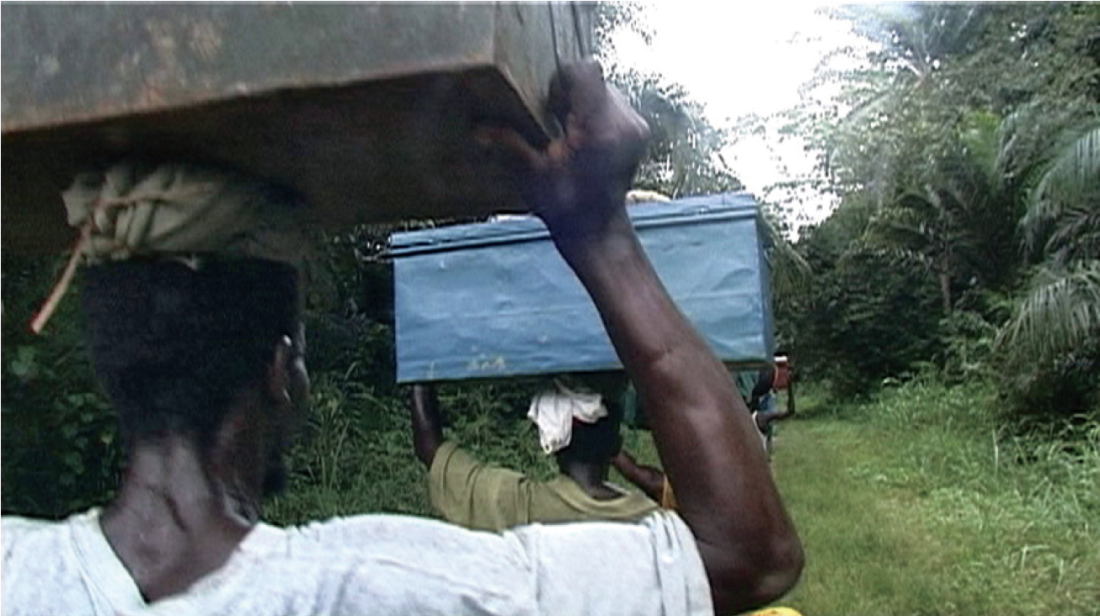“what is waiting out there” Sixth Berlin Biennale for Contemporary Art
Not quite a statement, nor explicitly a question, the theme chosen to frame the sixth Berlin Biennale is at once ominous and open-ended, conjuring v isions of the underrepresented, the oppressed or the ignored lurking in the distance, waiting to be uncovered. Despite the temporal and spatial dislocations the exhibition’s title implies, curator Kathrin Rhomberg claims that young artists are thinking less and less about the future, choosing instead to reinvestigate 20th-century concerns. Her biennale seeks to addresses this “new historicism” by presenting works that direct their gaze away from the formal and self-referential concerns of contemporary art and “outward, at reality.” As Rhomberg told Artforum’s Anthony Byrt, “it became urgent again for me to ask: Is there a relationship between art and the present moment, and if so, what does it look like?”
A challenging question, to say the least, and one that cannot easily be answered, even within the parameters of a mega-show like a biennale, the very structure of which is poised to respond to contemporary issues. According to Rhomberg, what defines our current moment, or at least the things she would like to direct our attention toward, are art practices that engage with social, economic and political “realities.” Wisely framing reality in the plural, Rhomberg is also concerned with the attendant gaps or cracks in reality, the distance between how things seem and how they are. Implicit in this question is how the invisible becomes visible and how anything—whether an individual, collectivity, idea or act—constitutes its own visibility. Indeed, the production of reality is one of the strongest themes to come out of Rhomberg’s thoughtful, though at times maddening, biennale.

Petrit Halilaj, installation view of The places I’m looking for, my dear, are utopian places, they are boring and I don’t know how to make them real, 2010, at Sixth Berlin Biennale for Contemporary Art, 2010, dimensions variable. Photograph: Uwe Walter, 2010. Courtesy the artist. Copyright the artist; Chert, Berlin.
In her attempt to take on such a slippery idea, Rhomberg strikes a modest tone, limiting the exhibition to 45 artists and moving the bulk of the biennale’s six exhibition venues away from the bustle and nouveau glitz of Berlin’s Mitte to Kreuzberg. An air of seriousness pervades “what is waiting out there,” which eschews the spectacular site-specific works often commissioned for biennales in favour of more subdued, if not ramshackle, installations and a curatorial tempo that tries to be deliberate but, instead, often comes off as stilted and heavy handed. The work itself is predictably austere. After dutifully marching through the exhibition’s six venues, some hidden on side streets and in unlikely locations, viewers may find themselves wondering, “Is this what reality looks like?” The exhibition halls at Kunst-Werke, the biennale’s flagship institution, feel practically empty, while visitors to the exhibition’s largest venue, a crumbling former department store on Kreuzberg’s Oranienplatz, are subjected to documentary video after documentary with little space to absorb the information contained therein.
An unfortunate by-product of this approach is that the works seem seldom to speak to each other. Indeed, the strongest relationships that emerge among works are often the most literal, like Renzo Martens’s Episode 3 and Mark Boulos’s All That Is Solid Melts into Air, though thankfully this does not diminish the seriousness or impact of either. Boulos’s two-channel video juxtaposes the frenetic trading floor of the Chicago futures market with the artist’s interviews with resistance fighters in the Nigerian River Delta, where the local ecosystem has been decimated in the interest of foreign oil companies. Between outlining how “no bullet, no knife, no dagger can cut him” and telling the artist never to come to see him again, an elderly Nigerian man sternly commands Boulos, “make them remember us,” a not-so-subtle reminder of both the complexity and responsibility inherent in image making. This thread continues in Episode 3, Renzo Martens’s controversial 90-minute video that suggests that poverty, like any other resource, is something that is bought, sold, traded and exploited. Under the guise of a self-obsessed gonzo artist-cum-journalist, Martens stages a number of community meetings and trains local wedding photographers to document their own misery for profit. The Congolese may be poor, Martens reminds them, but they at least have their poverty itself, which they are giving away for free. To this end, Martens introduces a blinking neon sign reading “ENJOY POVERTY” half way through the film as both a directive to the Congolese as well as a not-so-subtle indictment of Western consumption of Third World poverty.

Renzo Martens, Episode 3, 2008, DVD, colour, sound; two metal trunks, photographs made in collaboration with the Association des Photographes de Kanyabayonga, master tape, neon signs, certificate, 90 minutes. Courtesy the artist; Galerie Fons Welters, Amsterdam; Wilkinson Gallery, London. Copyright the artist.
While political engagement is one of the leitmotifs of the exhibition, also expressed in the protest videos of Minerva Cuevas (Mexico) and Bernard Bazile (France), politics and history are at their richest and most expressive in works that are less explicit. After navigating the prescribed entrance to the exhibition through Kunst-Werke’s basement, visitors are greeted by a few live hens and a large wooden structure created by the biennale’s youngest artist, the 24-year-old Kosovo-born Petrit Halilaj. Entitled The places I’m looking for, my dear, are utopian places, they are boring and I don’t know how to make them real, the work is created from reconstructed beams from his parents’ home. A minimal and poetic construction, the work is an evocative blend of the personal and political and one of the exhibition’s few doses of charm and humour. ❚
The sixth Berlin Biennale for Contemporary Art, “what is waiting out there,” curated by Kathrin Rhomberg, was exhibited in Berlin, Germany, from June 11 to August 8, 2010.
Jesi Khadivi is a writer and curator living in Berlin where she co-directs the project space Golden Parachutes.

